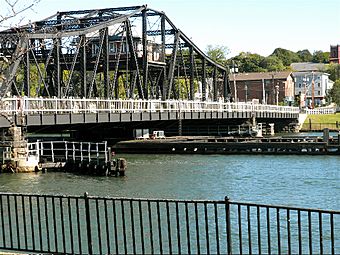Quinnipiac River Historic District facts for kids
Quick facts for kids |
|
|
Quinnipiac River Historic District
|
|

Grand Avenue Bridge (1896).
|
|
| Location | East Haven, Connecticut |
|---|---|
| Area | 313 acres (127 ha) |
| Architectural style | Greek Revival, Italianate, Queen Anne |
| NRHP reference No. | 84001139 |
| Added to NRHP | June 28, 1984 |
The Quinnipiac River Historic District is a special area in New Haven, Connecticut. It covers about 313 acres and sits along the Quinnipiac River. This district includes parts of the Fair Haven and Fair Haven Heights neighborhoods. It's like stepping back in time to the old maritime village of Fair Haven, which started way back in the 1700s.
This historic area was added to the National Register of Historic Places in 1984. At that time, it had 524 important buildings. It also includes a wetland near Hemingway Creek and the Grand Avenue Swing Bridge. This bridge connects Fair Haven with Fair Haven Heights right in the middle of the district.
Contents
Exploring Fair Haven's History
The village of Fair Haven began to grow in the early 1700s. It started around a place where people could cross the Quinnipiac River by ferry. Today, that's where the Grand Avenue bridge stands.
From Farms to Bridges
At first, Fair Haven was mostly a farming area outside of New Haven. Things really started to change when the first bridge was built in 1790. This made it much easier for people and goods to move around. You can still see some old taverns and houses from this early period in the district.
The Rise of Oyster Farming
By the mid-1800s, a new industry became very important here: oyster farming! People who owned land along the river, especially near the muddy areas, started harvesting and processing oysters. This became a huge part of the local economy.
Joining New Haven and Growing
In 1871, Fair Haven officially became part of New Haven. After that, it grew even more as New Haven's industries expanded. Fair Haven became a "streetcar suburb," meaning people could live there and easily travel to work by streetcar. But it still kept its focus on oyster farming and other related businesses.
Images for kids
-
Recessed Doric porch of double Greek revival house, 37-39 Grand Avenue, Fair Haven.








